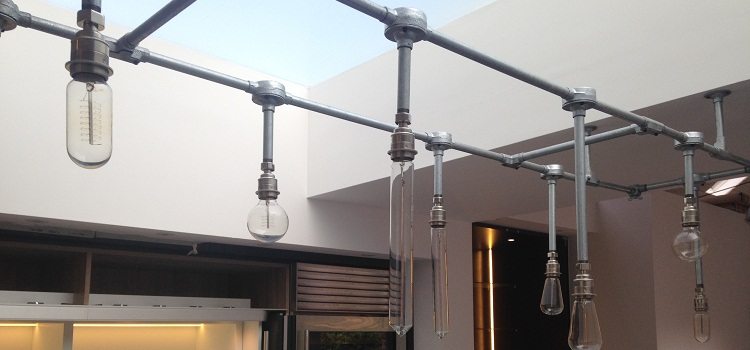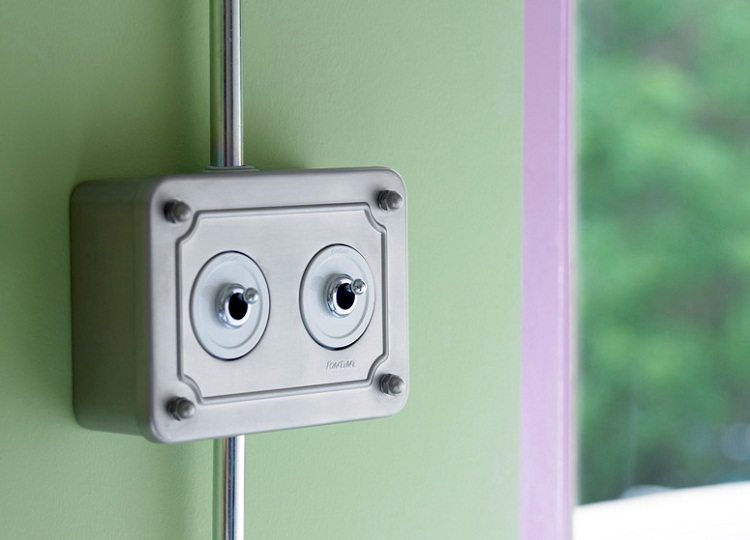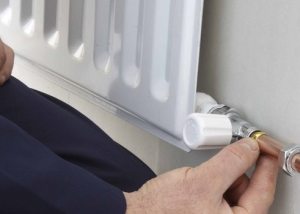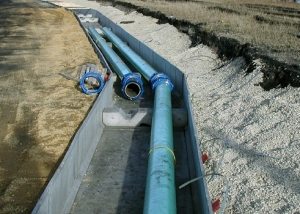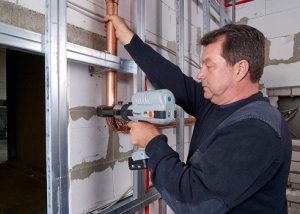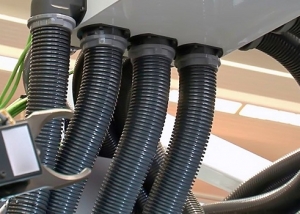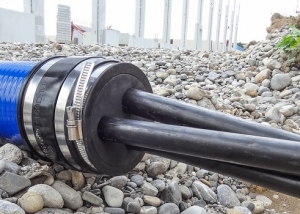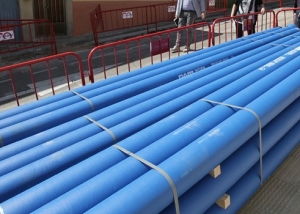Metal pipes can now be used for various purposes, one of which is wiring. The most difficult and important stage of cable laying is compliance with fire safety standards and requirements, especially if there are wooden structures. Metal pipes for electrical wiring can reliably protect communication networks from mechanical damage, as well as aggressive environments.
Content
Types of channels for electrical wiring
The choice of tube material depends on the type of room where the wiring is carried out, its conditions and features. Among the main channel materials for such purposes, there are:
- plastic;
- steel;
- copper;
- brass.
For the manufacture of plastic models, polyvinyl chloride, polyethylene (P) high (B) and low (H) pressure (D) are used. PVC products are the most popular due to their affordable cost, good indicators of heat resistance and strength. Common diameters are from 1.6 to 6.0 centimeters.
Plastic pipes are distinguished by a smooth surface, which facilitates the work of replacing conductors, low weight, corrosion resistance.
Note! PVC and polyethylene channels are dielectrics, which allows us to consider them as an additional insulating circuit.
Metal pipes for electrical wiring made of steel have a significant mass, however, they are characterized by a particularly high strength. Such products are recommended for use in wooden buildings. Since the material is a good conductor, then, to ensure electrical safety, all such channels must be grounded. Thin-walled brass or copper pipe is excellent for mounting on the surface of walls, as well as for concealed laying. She easily bends and does not always need decor.
Some installation rules
Before installing a cable route from thin-walled metal pipes for electrical wiring, you should familiarize yourself with the following rules:
- the ends of each piece of products need preliminary cleaning from burrs and countersink;
- the maximum allowable bending angle of the steel channel is 90 degrees;
- there is a limit on the length of the segments: up to 10 meters in the case of a straight pipe, up to 5 meters in the presence of 2 bends;
- when bending, it is important to monitor the integrity of the cross section of the product;
- the metal channel should be performed as part of the control system (potential equalization system).
If it is not possible to fulfill the conditions for choosing the length of the pipes, according to the rules, installation of a broaching box is required without additional joints.
The physical essence of the control system consists in the need to connect all the conductive parts into a single system so as to minimize or completely eliminate the potential difference between them. To do this, it must include:
- grounding device;
- the main (G) grounding (H) bus (W) mounted in the shield (Щ) of the metering (У) electricity (E) or the input shield;
- all elements of metal construction construction.
If you adhere to these rules, then you can greatly facilitate the installation and replacement of wiring.
Features of copper and brass cable channels
Copper wiring products are not in high consumer demand due to their high cost. Channels have these features:
- Compared to steel, neither brass nor copper is susceptible to active corrosion;
- the ability to quickly do it yourself with a wide selection of fittings and good bending features of thin-walled tubes;
- carefully polished and open-mounted ducts can serve as interior decoration.
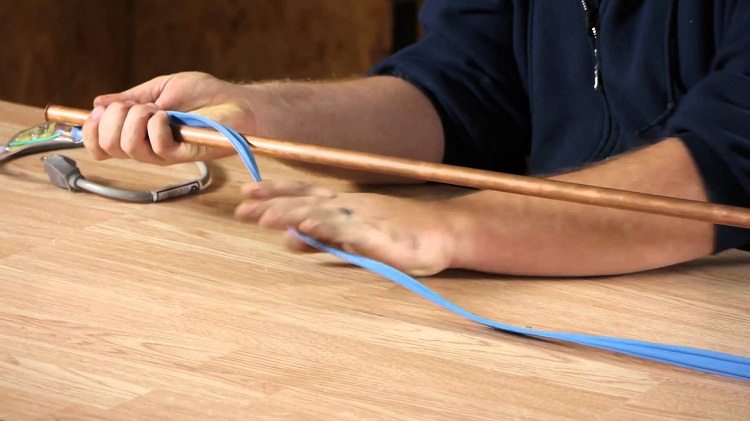
Copper pipes are not subject to corrosion, so such a cable channel will not need to be replaced for a long time
In addition, copper / brass tracks are durable and resistant to the negative effects of external factors.
Note! Since these metals have good thermal conductivity, they must be placed remotely from the heating pipes, otherwise there is a risk of melting the insulation and overheating of the wiring.
Another drawback of the choice of thin-walled cable channels is the inability to provide them with reliable protection against mechanical damage.
Steel pipe specifications
Conventional steel pipes are characterized by a wall thickness of more than 0.25 centimeters. The value of this indicator for thin-walled steel products ranges from 0.16 to 0.25 cm. It is strictly forbidden to use metal pipes if the surface of the aluminum wire is open.
The installation of thick-walled channels for steel wiring is usually done by welding and is expensive. Such products are relatively inexpensive, almost completely immune to temperature extremes and have high strength.
Manufacturers offer the market galvanized cable ducts for wiring. In other cases, additional processing is necessary by staining or varnishing. With a horizontal arrangement, it is recommended to form a slight slope towards the junction box to protect the pipe from condensation accumulation.
Since steel is thermally conductive, the structure should be protected from extreme temperatures. For this, it is necessary to ensure a distance of at least 50 millimeters between the heating and electrical wiring when they intersect. The distance from the cable channel to the heating system with parallel placement should be more than 10 cm.
In an open space, a steel pipe is attached with special clamps or pads every 250-300 centimeters.
Advantages of metal cable channels
The main advantages of metal channels for electrical wiring are:
- reliability;
- wear resistance;
- practicality;
- variety of decisions;
- stability of parameters;
- UV resistance;
- resistance to low / high temperatures.
Metal cable channels are able to provide stable protection of the wiring from moisture, rodents, mechanical stress and temperature extremes. They can be used for a long time, especially if covered with a protective layer. Such pipes do not require special maintenance.
Note! A wide variety of lengths, diameters, visual parameters and other characteristics of metal products makes it easy to select channels for electrical wiring that meet all the wishes of the consumer.
Metal pipes do not change the size and shape when observing the operating rules, are suitable for both hidden (internal) and open (external) wiring, and can also be used in unheated rooms.
Subtleties of using products
When using metal pipes, there may be some difficulty with pulling wires in them. There are several ways to do this. The easiest way is to stretch a steel wire into the channel, attach a cable to its edge and pull it in.
If the product has a substantial length, then you can insert a ball into it with a tied thin, but strong thread or tape. Talc is used to facilitate its movement. A steel wire is attached to the end of the thread / tape. Next, the nozzle of the air compressor is inserted into the hole and the equipment is turned on. Under the influence of pressure, the ball moves along the channel for electrical wiring, tightening the thread behind itself. Cut products with a hacksaw or grinder.
For switches and sockets, products with a diameter of 20 mm are usually selected; for lighting devices - 1.6 cm; for connections between floors - 4.0 cm; for connecting distribution panels or ducts - 25 mm. The length of the channels is usually 3-5 m.
If the room is characterized by increased humidity and the likelihood of having chemical substances, then thin-walled tubes with a cross section of about 20 mm can be used, connecting them with threadless couplings. With a high level of hazardous factors, it is better to take water and gas products with a diameter of 15-80 mm, joining them with threaded couplings.
Important Grounding Aspects
The main task of protective grounding is to ensure human safety from contact with electric current (ET). Its effect is as follows:
- at a current of 0.6-1.5 thousand μA, the effect of electricity on the body is felt;
- at 2-4 thousand μA - fingers begin to tremble;
- at 5-7 thousand μA - convulsions of the hands may occur;
- at 10-15 thousand μA - it is difficult to open the arm with the conductor on its own without help;
- at 20-25 thousand μA - severe pain is felt, breathing is difficult and it is impossible to detach the hand from the wire;
- at 50-80 thousand μA - malfunctions of the heart occur, respiratory paralysis occurs.
The critical current causing cardiac fibrillation and respiratory arrest is 100 thousand μA. 1 μA is the millionth of Ampere.
Note! The currents in the wiring (household) can have values of several tens of Amps.
In relation to the DC conductor or phase conductor, the earth has zero potential, which explains the use of grounding. The resistance value of the grounding device, equal to the ratio of the voltage on it to the current that goes into the ground, should be no more than 4 ohms.
Modern wiring is carried out only using a residual current device, which instantly responds to any leakage (unauthorized) current. There are such types of grounding systems: TN-C; TN-S; TN-C-S; TT IT.
Deciphering the letters in the first position: T - neutral neutral IP (power supply); I - all live parts of the equipment (including the working neutral wire) are isolated from the ground. Symbols in the second position mean: N - open conductive elements of the grounded devices are connected to the neutral IP; T - conductive parts of devices and electrical installations are grounded through a separate circuit. Letters through a hyphen: C - the functions of the zero protective and zero working conductor are combined in a single conductor; S - working and protective zero are provided by different conductors.
Corrugated metal pipes and smooth types of such pipes are great for laying hidden communications. Although today alternative corrugated or smooth polymer cable channels are increasingly used, steel / copper products surpass their characteristics in terms of strength and degree of mechanical protection.
